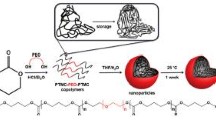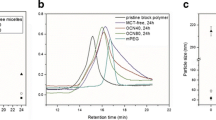Abstract
Purpose. To investigate the feasibility of producing freeze-dried poly-(ethylene oxide) (PEO)-surface modified nanoparticles and to study their ability to avoid the mononuclear phagocytic system (MPS), as a function of the PEO chain length and surface density.
Methods. The nanoparticles were produced by the salting-out method using blends of poly(D,L-lactic acid) (PLA) and poly(D,L-lactic acid-co-ethylene oxide) (PLA-PEO) copolymers. The nanoparticles were purified by cross-flow filtration and freeze-dried as such or with variable amounts of trehalose as a lyoprotectant. The redispersibility of the particles was determined immediately after freeze-drying and after 12 months of storage at −25° C. The uptake of the nanoparticles by human monocytes was studied in vitro by flow cytometry.
Results. PLA-PEO nanoparticles could be produced from all the polymeric blends used. Particle aggregation after freeze-drying was shown to be directly related to the presence of PEO. Whereas this problem could be circumvented by use of trehalose, subsequent aggregation was shown to occur during storage. These phenomena were possibly related to the specific thermal behaviours of PEO and trehalose. In cell studies, a clear relationship between the PEO content and the decrease of uptake was demonstrated.
Conclusions. The rational design of freeze-dried PEO-surface modified nanoparticles with potential MPS avoidance ability is feasible by using the polymer blends approach combined with appropriate lyoprotection and optimal storage conditions.
Similar content being viewed by others
REFERENCES
S. Stolnik, L. Illum, and S. S. Davis. Long circulating microparticulate drug carriers. Adv. Drug Del. Rev. 16:195–214 (1995).
V. P. Torchilin and V. S. Trubetskoy. Which polymers can make nanoparticulate drug carriers long-circulating? Adv. Drug Del. Rev. 16:141–155 (1995).
J. H. Lee, J. Kopecek, and J. D. Andrade. Protein-resistant surfaces prepared by PEO-containing block copolymer surfactants. J. Biomed Mater. Res. 23:351–368 (1989).
C. G. Gölander, J. N. Herron, K. Lim, P. Claesson, P. Stenius, and J. D. Andrade. Properties of immobilized PEG films and the interaction with proteins. Experiments and modeling. In J. M. Harris (ed.), Poly(Ethylene Glycol) Chemistry: Biotechnical and Biomedical Applications, Plenum Press, New York, 1992, pp. 221–245.
S. M. Moghimi. Mechanisms regulating body distribution of nanospheres conditioned with pluronic and tetronic block copolymers. Adv. Drug Del. Rev. 16:183–193 (1995).
S. Stolnik, S. E. Dunn, M. C. Garnett, M. C. Davies, A. G. A. Coombes, D. C. Taylor, M. P. Irving, S. C. Purkiss, T. F. Tadros, S. S. Davis, and L. Illum. Surface modification of poly(lactide-co-glycolide) nanospheres by biodegradable poly(lactide)-poly(ethylene glycol) copolymers. Pharm. Res. 11:1800–1808 (1994).
A. E. Hawley, L. Illum, and S. S. Davis. Preparation of biodegradable, surface engineered PLGA nanospheres with enhanced lymphatic drainage and lymph node uptake. Pharm. Res. 14: 657–661 (1997).
R. Gref, Y. Minamitake, M. T. Peracchia, V. S. Trubetskoy, V. P. Torchilin, and R. Langer. Biodegradable long circulating polymeric nanospheres. Science 263:1600–1603 (1994).
M. T. Peracchia, R. Gref, Y. Minamitake, A. Domb, N. Lotan, and R. Langer. PEG-coated nanospheres from amphiphilic diblock and multiblock copolymers: investigation of their drug encapsulation and release characteristics. J. Contr. Rel. 46:223–231 (1997).
D. Bazile, C. Prud'Homme, M. T. Bassoullet, M. Marlard, G. Spenlehauer, and M. Veillard. Stealth Me.PEG-PLA nanoparticles avoid uptake by the mononuclear phagocytes system. J. Pharm. Sci. 84:493–498 (1995).
B. G. Müller and T. Kissel. Camouflage nanospheres: a new approach to bypassing phagocytic blood clearance by surface modified particulate carriers. Pharm. Pharmacol. Lett. 3:67–70 (1993).
M. T. Peracchia, C. Vauthier, F. Puisieux, and P. Couvreur. Development of sterically stabilized poly(isobutyl 2-cyanoacrylate) nanoparticles by chemical coupling of poly(ethylene glycol). J. Biomed. Mater. Res. 34:317–326 (1997).
W. M. Stevels, M. J. K. Ankoné, P. J. Dijkstra, and J. Feijen. Stereocomplex formation in ABA triblock copolymers of poly(lactide) (A) and poly(ethylene glycol) (B). Macromol. Chem. Phys. 196:3687–3694 (1995).
J. C. Leroux, F. De Jaeghere, B. M. Anner, E. Doelker, and R. Gurny. An investigation on the role of plasma and serum opsonins on the internalization of biodegradable poly(D,L-lactic acid) nanoparticles by human monocytes. Life Sci. 57:695–703 (1995).
E. Allémann, E. Doelker, and R. Gurny. Drug loaded poly(lactic acid) nanoparticles produced by a reversible salting-out process: purification of an injectable dosage form. Eur. J. Pharm. Biopharm. 39:13–18 (1993).
J. C. Leroux, P. Gravel, L. Balant, B. Volet, B. M. Anner, E. Allémann, E. Doelker, and R. Gurny. Internalization of poly(D,L-lactic acid) nanoparticles by isolated human leukocytes and analysis of plasma proteins adsorbed onto the particles. J. Biomed. Mater. Res. 28:471–481 (1994).
C. J. Van Oss. Phagocytosis: an overview. Methods Enzymol. 132:3–15 (1986).
J. W. Vanderhoff and S. El-Aasser. Theory of colloids. In H. A. Lieberman, M. M. Rieger, and G. S. Banker, (eds), Pharmaceutical dosage forms: dispersed systems, Marcel Dekker, New York, 1988, pp. 93–149.
J. F. Carpenter, S. J. Prestrelski, and T. Arakawa. Separation of freeze-and drying-induced denaturation of lyophilized proteins using stress-specific stabilization I. Enzyme activity and calorimetric studies. Arch. Biochem. Biophys. 303:456–464 (1993).
M. C. Heller, J. F. Carpenter, and T. W. Randolph. Effects of phase separating systems on lyophilized hemoglobulin. J. Pharm. Sci. 85:1358–1362 (1996).
K.-I. Izutsu, S. Yoshioka, S. Kojima, T. W. Randolph, and J. F. Carpenter. Effects of sugar and polymers on crystallization of poly(ethylene glycol) in frozen solutions: phase separation between incompatible polymers. Pharm. Res. 13:1393–1400 (1996).
M. Arakawa, Y. Kita, and J. F. Carpenter. Protein-solvent interactions in pharmaceutical formúlations. Pharm. Res. 8:285–291 (1991).
T. Verrecchia, G. Spenlehauer, and D. V. Bazile. Non-stealth (poly(lactic acid/albumin)) and stealth (poly(lactic acid-polyethylene glycol)) nanoparticles as injectable drug carriers. J. Contr. Rel. 36:49–61 (1995).
M. Auvillain, G. Cavé, H. Fessi, and J. P. Devissaguet. Lyophilisation de vecteurs colloidaux submicroniques. S. T. P. Pharma 5:738–744 (1989).
G. Strauss, P. Schurtenberger, and H. Hauser. The interaction of saccharides with lipid bilayer vesicles: stabilization during freeze-thawing and freeze-drying. Biochim. Biophys. Acta 858:169–180 (1986).
D. P. Miller, J. J. de Pablo, and H. Corti. Thermophysical properties of trehalose and its concentrated aqueous solutions. Pharm. Res. 14:578–590 (1997).
X. S. Wu. Synthesis and properties of biodegradable lactic/glycolic acid polymers. In D. L. Wise (ed.), Encyclopedic handbook of biomaterials and bioengineering, Marcel Dekker, New York, 1995, pp. 1015–1054.
J. Bamba, G. Cavé, Y. Bensouda, P. Tchoreloff, F. Puisieux, and G. Couarraze. Cryoprotection of emulsions in freeze-drying: freezing process analysis. Drug Dev. Ind. Pharm. 21:1749–1760 (1995).
K.-I. Izutsu, S. Yoshioka, and T. Terao. Decreased protein-stabilizing effects of cryoprotectants due to crystallization. Pharm. Res. 10:1232–1237 (1993).
F. Franks. Freeze-drying of bioproducts: putting principles into practice. Eur. J. Pharm. Biopharm. 45:221–229 (1998).
S. I. Jeon, J. H. Lee, J. D. Andrade, and P. G. De Gennes. Protein-surface interactions in the presence of polyethylene oxide. I. Simplified theory. J. Colloid Interface Sci. 142:149–158 (1991).
W. R. Gombotz, W. Guanghui, T. A. Horbett, and A. S. Hoffman. Protein adsorption to poly(ethylene oxide) surfaces. J. Biomed. Mater. Res. 25:1547–1562 (1991).
Author information
Authors and Affiliations
Corresponding author
Rights and permissions
About this article
Cite this article
De Jaeghere, F., Allémann, E., Leroux, JC. et al. Formulation and Lyoprotection of Poly(Lactic Acid-Co-Ethylene Oxide) Nanoparticles: Influence on Physical Stability and In Vitro Cell Uptake. Pharm Res 16, 859–866 (1999). https://doi.org/10.1023/A:1018826103261
Issue Date:
DOI: https://doi.org/10.1023/A:1018826103261




